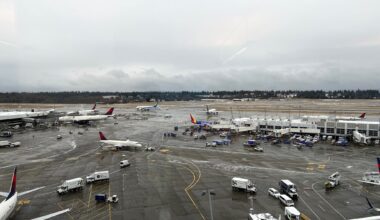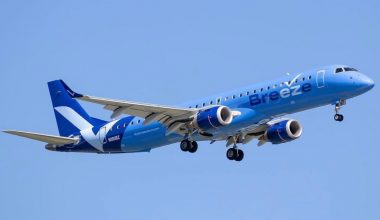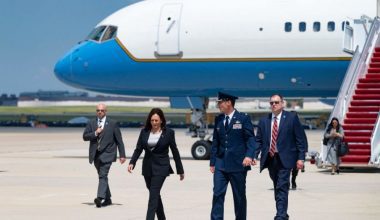American Airlines, the world’s largest airline, headquartered in Fort Worth, Texas, permit one carry-on bag and one personal item free of charge for each passenger in its flight. The individual item can be a briefcase, or wallet, or leather laptop bag. The personal items need to be appropriately sized, fit under the seat, and comply with the carrier’s rules.

The size affixed for carry-on baggage in American Airlines:
- 45 linear inches (22x14x9 inches)
- Or 115 centimeters (56x36x23 cm), including all handles, side pockets, and wheels.

That means the maximum dimensional length for carry-on bags is 45 inches and a weight of 40 pounds.
The personal items must not exceed the dimension of 18x14x8 inches or 45x35x20cm. The maximum dimensional length for the individual item is 36 inches.
The bulkhead seats don’t possess under-seat storage, so all the cabin baggage needs to be stowed in the overhead compartment by passengers in American Airlines during flight take-off and landing.

The things that don’t count as carry-on baggage allowance
• Jacket
• Umbrella
• Duty-free articles
• Child restraint seats
• Walkers
• Wheelchairs
• Baby strollers
• Diaper bags for a lap or ticketed child
The restricted items on carry-on baggage
• Razor blades or meat cleavers
• Flammable items
• Explosive goods such as flares
• Liquid bottle larger than 34 ounces
However, if passengers making use of oxygen tank makes arrangements by obtaining prior approval, at least 48 hours advance, from American Airlines, then they are permitted to bring such medical oxygen generators despite their size and explosive concentrators.
The soft-sided garment bags that don’t exceed 51 inches/ 30 cm (length+ breadth+ height) can also be considered a carry-on item in American Airlines. As long as they fit under the seat or in the overhead compartment, the musical instruments can be taken as carry-on items.
What is Baggage?
Baggage refers to personal items or effects and possessions carried by travelers such as clothes, cameras, equipment, and other articles in relation to his/their trip. In other words, baggage is the article, effect, or personal property of travelers accompanying them in their journey, required for comfort, wear, or use. The baggage includes both checked and unchecked baggage.

American Airlines Checked Baggage Policy
On domestic, transatlantic, and transpacific flights, American Airlines allows the passengers to check up to 10 bags. Similarly, if the passenger is traveling to/through or from Mexico/ Caribbean or Central America, South America, and Brazil, five bags can be checked in on American-operated flights.
Weight and size of the checked bag on American Airlines
The size limit for checked bags:
Dimension- 62 inches/158 cm
Weight-70 lbs/32 kgs for complementary bags
– 50lbs/23 kgs for excess charged bags
For all regions, excluding flights to/from Australia or New Zealand, the size limit is
Dimension-62 inches/158 cm
Weight- 50lbs/23kgs
For confirmed customers on first/business class, the allowed checked baggage weight is 70 lbs/ 32 kgs. The total of 3 dimensions (length, breadth, height) must not exceed 62 inches for each piece of bag, and weight must not exceed 23 kg per bag.
Provision of Carry-on pets on American Airlines
Carry-on pets are limited to cats and dogs on American Airlines, which meet the requirements regarding size, age, and destination. The animals can be transported or carried on depending on the pet size and breed.
The service dogs (guide dogs, assistant dogs) may fly in the cabin free of charge provided the dog is traveling with the owner, and the passenger is dependent on the dog fully. Fees and restrictions apply when traveling with pets.

If the passenger has paid for the carry-on pet, then the kennel is allowed as a carry-on bag on an American Airlines flight, provided the pet stays in the kennel and under the seat for the entire flight. Since the kennel will replace carry-on bags, the passengers will only be allowed to bring a pet carrier and personal items.
But if the pet is too large to be carry-on in the cabin, it must be transported as cargo in American Airlines cargo. The checked pet for active-duty US military and US State Department Foreign Service Personnel traveling on official orders will be accepted by American Airlines.
The arrangement for the carriage of pet animals needs to be notified before the trip, at least 48 hours prior. The pet strollers must be checked at the check-in counter, and the pet carrier must meet all the kennel guidelines for carry-on pets. The essential guidelines/rules are:
• The pet should be able to stand and sit erect or lie down in the kennel without touching the side or top of the kennel.
• The kennel must have ventilation, must be secured and padded.
The carry-on pets are not permitted in First/Business class due to lack of under-seat storage space on Boeing aircraft of American Airlines, i.e., on 777-200, 777-300, 787-8, and 787-9.
The pets must have health certificates, have a complete checklist, and check-in with official orders. American Airlines allows its customers to travel with pets on most flights from/to:
- The US and Canada
- Within 48 contiguous United States
- Alaska
- Central America
- Mexico
- St. Croix
- St Thomas
- Puerto Rico
General baggage formalities in the airport
Check-in is the domain that comprises of carrying out all procedures for acceptance of passengers and their baggage on flight and culminates in traveling passengers getting their boarding passes to board the aircraft. Passengers’ baggage is handed over to the check-in counter. They receive a boarding pass. Following this, they clear immigration, pass through the security check area where hand baggage is x-rayed, and frisking of passengers takes place for security reasons. Finally, the passengers proceed to the boarding gates.

One of the vital airline operations is the checking-in of the customers and their luggage.
When the passenger purchases the ticket, it may include the air transportation of the passenger as well as their luggage. The price he/she paid for the ticket signifies the type of seat and class of service the passenger gets and the baggage allowance.
The passenger’s amount of luggage is permitted to carry free of cost or which is already included in the ticket is known as baggage allowance. The allowance applies to both the checked as well as unchecked baggage. The baggage allowance is mentioned in the air ticket (either weight or piece concept). Each airline designates its own baggage allowances for the customer and the applicable charges. For interline journey (which consists of flight itinerary of more than one airline), it is IATA that determines the charges.
There are two types of baggage in passenger journey=carry-on baggage (cabin baggage) and check-in baggage.
1. Carry-on/Hand Baggage/Cabin Baggage
It is also known as unchecked baggage. It is such baggage of which the travelers retain control and custody. It is called cabin baggage because it can be carried in the cabin, within the passenger’s control. Every carry-on bag must meet the operating airline standard for the weight, size, and intended number of pieces. The carry-on baggage is also weighed to ensure their adherence to the standard specified weight and size limit. Instead of being placed in a separate cargo compartment, the carry-on bags are allowed to be kept with passengers onboard the aircraft. Storage space is provided either under the seat of the overhead bin. The passengers keep valuable items and articles needed during the journey. The essential travel documents, medicine, passports, electronic items such as mobiles, cameras, etc., are allowed in hand luggage. The requirements for carry-on bags vary according to the airlines. Yet IATA provides guidelines for the cabin baggage size. The airlines don’t permit free baggage at all.

According to the Warsaw Convention, an airline’s liability for the loss, delay, or damage to the baggage is limited, despite the assumption of responsibility, until the passenger has declared the higher value in advance and paid additional charges for it. This liability is excluded to:
- Passports
- Fragile items
- Business documents
- Money, credit cards, or other valuable items
- Laptops, computers, or PCs
- Samples
The passenger should keep all these items in their cabin baggage.
Conditions that Carry-on bags can’t be accepted:
- Unsuitable to carry by air due to its nature, weight, or size. It can’t be stowed in the overhead locker or carried under the seat. It is not packed adequately or has unsuitable packing.
- The restricted items, which are not following current regulations, such as liquids, aerosols, and gels, are contained in carry-on bags.
- Carries the articles not acceptable to security screening.
- No approval has been given to carry certain things due to their nature, size, or weight by the operating airline.
Normally, the cabin bags should have a maximum length of 56 cm (22 inches). The width can be a maximum of 45 cm (18 inches), and the maximum depth should be 25 cm (10 inches) which includes all wheels, handles, and side pockets.
2. Checked baggage
The baggage whose custody is taken by the airline is checked baggage. The airline issues a baggage tag for checked baggage. It is kept in the hold of aircraft and checked-in at the check-in counter.





